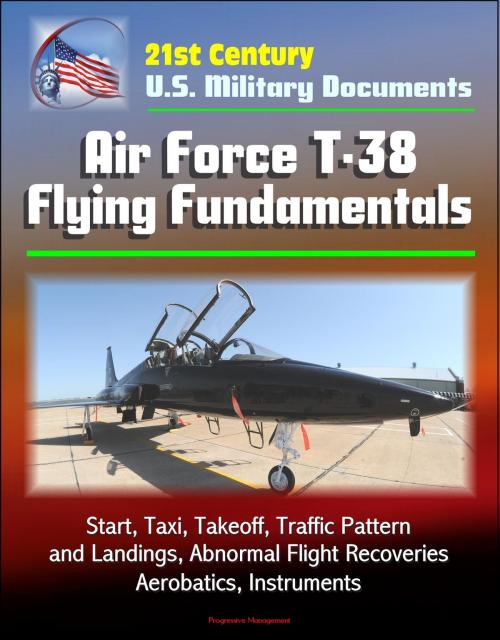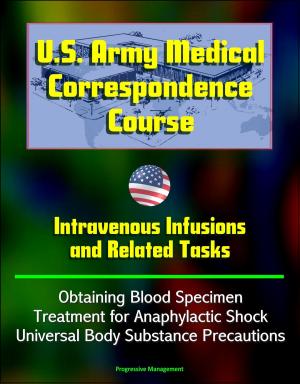21st Century U.S. Military Documents: Air Force T-38 Flying Fundamentals - Start, Taxi, Takeoff, Traffic Pattern and Landings, Abnormal Flight Recoveries, Aerobatics, Instruments
Nonfiction, Science & Nature, Technology, Aeronautics & Astronautics, History, Military, Aviation| Author: | Progressive Management | ISBN: | 9781310634642 |
| Publisher: | Progressive Management | Publication: | November 15, 2013 |
| Imprint: | Smashwords Edition | Language: | English |
| Author: | Progressive Management |
| ISBN: | 9781310634642 |
| Publisher: | Progressive Management |
| Publication: | November 15, 2013 |
| Imprint: | Smashwords Edition |
| Language: | English |
This manual implements AFPD 11-2, Aircraft Rules and Procedures. It provides a comprehensive document containing T-38 fundamental procedures and techniques that may be used to accomplish the various missions of the T-38. It presents a solid foundation on which student training missions can be accomplished and instructor continuation training can be maintained. It is not designed to be used as a step-by-step checklist of how to successfully employ the T-38, but to provide information and guidelines on basic procedures and techniques.
Chapter 1 * MISSION PREPARATION * 1.1. Objectives * 1.2. Mission Briefing * 1.3. Debrief * Chapter 2 * START, TAXI, TAKEOFF, CLIMB, AND LEVELOFF * 2.1. Checklist Discipline * 2.2. Preflight * 2.3. End of Runway (EOR) * 2.4. Taking the Active Runway * 2.5. Takeoff * 2.6. Takeoff Roll * 2.7. Climb * 2.8. Leveloff * 2.9. Cruise * 2.10. Abnormal Procedures * Chapter 3 * TRAFFIC PATTERN AND LANDINGS * 3.1. Introduction * 3.2. Judgment in the Traffic Pattern * 3.3. Wind Analysis * 3.4. General Approach and Landing Information * 3.5. Normal Straight-In * 3.6. Normal Overhead (Full or 60-Percent Flaps) * 3.7. Normal Final Approach or Landing * 3.8. Full-Stop Landing and Aerobrake * 3.9. Rollout and Wheel-Braking * 3.10. Touch-and-Go Landing * 3.11. Crosswind Landing * 3.12. No-Flap Patterns and Landings * 3.13. Single-Engine Patterns and Landings * 3.14. Single-Engine Go-Around * 3.15. Low-Closed Traffic Pattern * 3.16. Traffic Pattern Irregularities * 3.17. Go-Around * 3.18. Alternate Gear Extension * 3.19. Abnormal Procedures * Chapter 4 * CONTACT * Section 4A General Methods and Procedures * 4.1. Introduction * 4.2. Area Orientation * 4.3. Energy Management * 4.4. Flight Control Characteristics * 4.5. Pilot-Induced Oscillations (PIO) * 4.6. G-Awareness Exercise * Section 4B Aircraft Handling Maneuvers * 4.7. General * 4.8. Full Aft-Stick Stall * 4.9. Simulated Trim Failure * 4.10. Rudder Effectiveness Exercise (Clean) * 4.11. Rudder Effectiveness Exercise (Configured) * 4.12. Aileron Effectiveness Exercise * 4.13. Acceleration Exercise * 4.14. Accelerated Stall * 4.15. Turn Reversals * 4.16. Pitchback * 4.17. Sliceback * 4.18. Low-Speed Stability Exercise * 4.19. Supersonic Flight * 4.20. Slow Flight * 4.21. Slow Flight Recovery Demonstration * Section 4C Traffic Pattern Stalls and Approach-to-Stall Training * 4.22. Purpose * 4.23. Turning Approach-to-Stall Exercise * 4.24. Landing Attitude Approach-to-Stall Exercise * 4.25. Stall and Approach-to-Stall Recovery Completion * Section 4D Abnormal Flight Recoveries * 4.26. Purpose * 4.27. Abnormal Recovery Setup Guidelines * 4.28. Nose-High Recovery * 4.29. Nose-Low Recovery * Section 4E Aerobatic Maneuvers * 4.30. Purpose * 4.31. Aerodynamic Parameters * 4.32. Factors Affecting Aerobatic Maneuvers in the Vertical * 4.33. Energy and Airspace Requirements * 4.34. Aileron Roll * 4.35. Lazy Eight * 4.36. Barrel Roll * 4.37. Loop * 4.38. Split-S * 4.39. Immelmann * 4.40. Cuban Eight * 4.41. Cloverleaf * 4.42. Chandelle * Chapter 5 * FORMATION * Section 5A Formation Administration * 5.1. Introduction * 5.2. Responsibilities * 5.3. Radio Discipline and Procedures * 5.4. Visual Signals * 5.5. In-Flight Checks * 5.6. Lead Changes * 5.7. Ground Operations * 5.8. Area, MOA, or Route * 5.9. Knock-It-Off or Terminate * 5.10. Recovery * Section 5B Basic Formations * 5.11. Fingertip Formation * 5.12. Route Formation * 5.13. Chase * 5.14. Spread * 5.15. Echelon * 5.16. Crossunder * 5.17. Pitchout * 5.18. Take Spacing * 5.19. Practice Lost Wingman Exercise * 5.20. Rejoins * 5.21. Overshoots * 5.22. Breakout * 5.23. Close Trail * 5.24. Fighting Wing * 5.25. Extended Trail * Section 5C Tactical Formations * 5.26. Types and Principles * 5.27. Line Abreast (Tactical) * 5.28. Tactical Turns * 5.29. Delayed 90-Degree Turns
This manual implements AFPD 11-2, Aircraft Rules and Procedures. It provides a comprehensive document containing T-38 fundamental procedures and techniques that may be used to accomplish the various missions of the T-38. It presents a solid foundation on which student training missions can be accomplished and instructor continuation training can be maintained. It is not designed to be used as a step-by-step checklist of how to successfully employ the T-38, but to provide information and guidelines on basic procedures and techniques.
Chapter 1 * MISSION PREPARATION * 1.1. Objectives * 1.2. Mission Briefing * 1.3. Debrief * Chapter 2 * START, TAXI, TAKEOFF, CLIMB, AND LEVELOFF * 2.1. Checklist Discipline * 2.2. Preflight * 2.3. End of Runway (EOR) * 2.4. Taking the Active Runway * 2.5. Takeoff * 2.6. Takeoff Roll * 2.7. Climb * 2.8. Leveloff * 2.9. Cruise * 2.10. Abnormal Procedures * Chapter 3 * TRAFFIC PATTERN AND LANDINGS * 3.1. Introduction * 3.2. Judgment in the Traffic Pattern * 3.3. Wind Analysis * 3.4. General Approach and Landing Information * 3.5. Normal Straight-In * 3.6. Normal Overhead (Full or 60-Percent Flaps) * 3.7. Normal Final Approach or Landing * 3.8. Full-Stop Landing and Aerobrake * 3.9. Rollout and Wheel-Braking * 3.10. Touch-and-Go Landing * 3.11. Crosswind Landing * 3.12. No-Flap Patterns and Landings * 3.13. Single-Engine Patterns and Landings * 3.14. Single-Engine Go-Around * 3.15. Low-Closed Traffic Pattern * 3.16. Traffic Pattern Irregularities * 3.17. Go-Around * 3.18. Alternate Gear Extension * 3.19. Abnormal Procedures * Chapter 4 * CONTACT * Section 4A General Methods and Procedures * 4.1. Introduction * 4.2. Area Orientation * 4.3. Energy Management * 4.4. Flight Control Characteristics * 4.5. Pilot-Induced Oscillations (PIO) * 4.6. G-Awareness Exercise * Section 4B Aircraft Handling Maneuvers * 4.7. General * 4.8. Full Aft-Stick Stall * 4.9. Simulated Trim Failure * 4.10. Rudder Effectiveness Exercise (Clean) * 4.11. Rudder Effectiveness Exercise (Configured) * 4.12. Aileron Effectiveness Exercise * 4.13. Acceleration Exercise * 4.14. Accelerated Stall * 4.15. Turn Reversals * 4.16. Pitchback * 4.17. Sliceback * 4.18. Low-Speed Stability Exercise * 4.19. Supersonic Flight * 4.20. Slow Flight * 4.21. Slow Flight Recovery Demonstration * Section 4C Traffic Pattern Stalls and Approach-to-Stall Training * 4.22. Purpose * 4.23. Turning Approach-to-Stall Exercise * 4.24. Landing Attitude Approach-to-Stall Exercise * 4.25. Stall and Approach-to-Stall Recovery Completion * Section 4D Abnormal Flight Recoveries * 4.26. Purpose * 4.27. Abnormal Recovery Setup Guidelines * 4.28. Nose-High Recovery * 4.29. Nose-Low Recovery * Section 4E Aerobatic Maneuvers * 4.30. Purpose * 4.31. Aerodynamic Parameters * 4.32. Factors Affecting Aerobatic Maneuvers in the Vertical * 4.33. Energy and Airspace Requirements * 4.34. Aileron Roll * 4.35. Lazy Eight * 4.36. Barrel Roll * 4.37. Loop * 4.38. Split-S * 4.39. Immelmann * 4.40. Cuban Eight * 4.41. Cloverleaf * 4.42. Chandelle * Chapter 5 * FORMATION * Section 5A Formation Administration * 5.1. Introduction * 5.2. Responsibilities * 5.3. Radio Discipline and Procedures * 5.4. Visual Signals * 5.5. In-Flight Checks * 5.6. Lead Changes * 5.7. Ground Operations * 5.8. Area, MOA, or Route * 5.9. Knock-It-Off or Terminate * 5.10. Recovery * Section 5B Basic Formations * 5.11. Fingertip Formation * 5.12. Route Formation * 5.13. Chase * 5.14. Spread * 5.15. Echelon * 5.16. Crossunder * 5.17. Pitchout * 5.18. Take Spacing * 5.19. Practice Lost Wingman Exercise * 5.20. Rejoins * 5.21. Overshoots * 5.22. Breakout * 5.23. Close Trail * 5.24. Fighting Wing * 5.25. Extended Trail * Section 5C Tactical Formations * 5.26. Types and Principles * 5.27. Line Abreast (Tactical) * 5.28. Tactical Turns * 5.29. Delayed 90-Degree Turns















